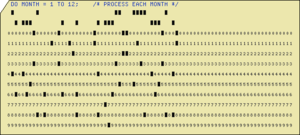Category Archives for Design
Taking the Blinders Off to Find Good HC IT Products
 |
If I write something on a piece of paper and put it into a file cabinet, I can go back and retrieve it whenever I want it. This is how most healthcare information systems work. It is really important, and pretty challenging, but it is also long past time that healthcare executives and buyers of healthcare IT demand far more for their (millions of) dollars. This limited input/store/retrieve model is as outdated as punch cards. |
A user of such an outdated system can’t ask a complex or developmental question and receive a refined answer, nor request analysis to enhance understanding or knowledge. With a giant digital file cabinet, it’s up to the human to do all the complex tasks and analyses—often a time consuming and possibly error-prone undertaking.
The workaround for healthcare delivery organizations is the hiring of data analysts to work between clinical managers and the system. This ignores and exacerbates two really big problems: the Total Cost of Ownership (TCO) for the solution, which is seldom discussed frankly (or remembered from previous experiences); and the delay and disjointedness in the workflow of clinical and senior management in trying to gain insight and make decisions.
Users should demand that the systems they use automatically process information rather than just store it. They need simple and fast access to insights that are understood and anticipated by system designers. They need what they get out of the system to be of higher value than what they put in. And, as much as anything, clinical experts and managers should not have to turn into technical data analysts, or work through them, to do their own jobs.
It should come as no surprise that the key to incorporating more complex abilities resides in the system design. A well-designed system could be instrumental in transforming the processes and culture of the entire enterprise, simply by the way it works and the way in which users interface with it.
System designers’ involving users is the right thing to do. However, as in many things, the critical part is in how and how well one does the right thing. When software developers follow the input of hands-on users verbatim, the results are frequently disappointing and almost always lacking in innovation. Users should inform the design process about their environment and objectives, about what insights will help them do their jobs better. They should not be the final word on how forms should be laid out or data presented, because there is a tendency to recreate the past in terms of paper forms and the processes built around them. This will only bring inefficiencies from previous systems into the current one; it may look familiar on screen, but it’s not going to be the powerful analytical asset that it could be.
To be of most value, system design needs to take the whole enterprise into account. It must consider processes and workflows that cross departments and functions, how the technology can do as much mechanical stuff for users as possible, make navigation and workflow intuitive, and chain together steps that make up users’ typical working functions. This takes a more holistic, flowing and comprehensive view than the more linear and choppy collection of tasks that many software developers tend to take. And it takes a little art thrown in with the science to figure out how to organize and analyze the information that gets put into the system so that the most people get the best use of its useful, insightful finished products.
System design must move beyond the “giant file cabinet” paradigm in order to achieve a better solution. The good news is that many software companies are doing just that, and we will see very positive outcomes as more and more hospitals move beyond simple input-storage-retrieval and use technology to enhance understanding and insight.
